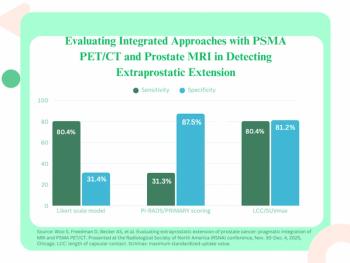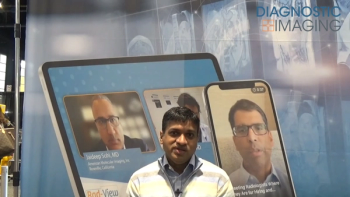
Portable Imaging and Radiology: Where Things Stand with Point-of-Care Diagnostics
While the research reveals key benefits with portable imaging, particularly point-of-care ultrasound applications with AI capabilities, these authors note challenges with variability in training and advocate for radiologist-led oversight.
Radiology is no longer confined to fixed infrastructure. With the rapid evolution of handheld ultrasound, wireless X-ray systems, and compact imaging platforms, diagnostic capabilities are reaching the bedside, emergency departments, and even remote or resource-limited environments. These innovations are reshaping clinical workflows by improving access and accelerating time-sensitive diagnoses.1,2 However, this shift also introduces considerations around training, quality assurance, and the evolving role of radiologists.
Portable imaging supports immediate decision-making in emergency departments, intensive care units, and rural clinics by eliminating delays associated with patient transport and scheduling. Studies confirm that point-of-care imaging improves outcomes in both acute and chronic disease management, particularly in underserved settings where diagnostic delays can lead to preventable mortality.3,4
The integration of portable imaging into trauma protocols, prenatal screening, and outpatient workflows underscores its growing clinical utility. Global health authorities, including the World Health Organization (WHO) and the Pan American Health Organization (PAHO), emphasize scalable diagnostics as essential to addressing the burden on noncommunicable diseases.5,6
Expanding the User Base
Technological advancements have expanded the user base of imaging tools. Devices once limited to radiologists and technicians are now used by general practitioners, nurses, and paramedics. Artificial intelligence (AI)-assisted platforms enhance accessibility by supporting novice users with image optimization and interpretation guidance.7,8 While point-of-care ultrasound (POCUS) reduces costs and improves care in primary settings, there is variation in training standards and implementation. A lack of universal guidelines for credentialing and use across clinical settings introduces variability and potential risks.9,10
Training and Competency: Bridging the Gap
Radiologists can offer valuable insight into the strengths and limitations of POCUS, such as variability in image quality and interpretation, particularly when it is used by clinicians with limited ultrasound training. The expertise of radiologists in image interpretation, developed through years of training and collaboration with sonographers, remains essential in ensuring diagnostic accuracy. However, structured training programs can significantly close this gap. A study of family medicine residents showed that a four-week POCUS curriculum improved knowledge scores from 62 percent to 84 percent and scanning skills from 41 percent to 85 percent.11,12 Findings from Kameda and colleagues reinforce that POCUS cannot be used effectively on an ad hoc basis. Competency-based education and ongoing assessment are essential.13
A Closer Look at Diagnostic Accuracy in Focused Applications
When used within defined protocols and by trained clinicians, POCUS achieves diagnostic accuracy comparable to radiologist-interpreted scans. Emergency physicians using handheld ultrasound confirmed abdominal pathologies with over 90 percent specificity and high negative predictive value.14,15 In pediatrics, non-radiologists diagnosed intussusception with 89 to 100 percent sensitivity and 95 to 99 percent specificity across multiple studies.16-19 Collectively, these findings reinforce the reliability of POCUS in focused applications, provided that clinicians receive appropriate training and operate within a clearly defined scope.
Overuse and Oversight: When Is It Too Much?
Overuse of imaging is a recognized systemic challenge, which may be influenced by factors such as defensive medicine, limited experience, and increased device availability.20
However, implementation of dedicated internal medicine POCUS services has been associated with reductions in unnecessary imaging requests. In one acute internal medicine service, over 70 percent of POCUS exams avoided departmental imaging, and more than half didn’t lead to any follow-up requests, demonstrating a clear reduction in imaging demand.21
Studies also show that POCUS reduces radiologist workload while enhancing documentation, billing compliance, and revenue tracking.21,22 Additionally, institutional guidelines for POCUS use have led to reductions in advanced imaging volume, radiation exposure, and environmental impact.23 Institutional strategies, such as a multi-step implementation protocol, help ensure proper utilization and support billing, quality assurance, and continuity of care.22 These approaches emphasize the role of structured protocols in guiding appropriate use, streamlining workflows, reducing diagnostic redundancy, and supporting high-quality care. Collectively, these strategies underscore the value of institutional oversight in promoting sustainable imaging practices.23
Professional societies emphasize the need for credentialing and oversight. The European Society of Paediatric Radiology and the American College of Emergency Physicians recommend strict boundaries, quality assurance, and training standards to prevent false negatives and ensure patient safety.24,25 Radiologists can play a pivotal role in developing and enforcing these standards, ensuring that POCUS is used safely and effectively across specialties.
Pertinent Insights on Clinician Perspectives and Institutional Barriers
Surveys of internal medicine residents show strong interest in POCUS but cite barriers such as lack of structured training, quality monitoring, and skill retention.26 Additionally, while point-of-care testing offers clear benefits, its accuracy can be compromised by user error, environmental conditions, and cost constraints, especially in resource-limited settings.27
Addressing these barriers requires institutional investment in training infrastructure, mentorship, and quality control systems. Some radiologists support a collaborative model in which radiologists lead integration efforts while supporting other clinicians’ skill development.28 The Radiological Society of North America (RSNA) has also highlighted growing institutional interest in standardizing POCUS practices, emphasizing the need for radiologists to help define training and credentialing pathways to ensure safety and consistency across specialties.29
(Editor’s note: For related content, see “
Key Recommendations for Implementation
• Structured training. Implement standardized POCUS curricula that prioritize skill acquisition and ongoing assessment.
• Radiology-led oversight. Establish credentialing pathways and quality assurance mechanisms under radiologist supervision.
• Focused applications. Limit POCUS use to validated, high-yield tasks such as FAST exams and pediatric intussusception evaluation.
• Early integration in medical education. Introduce ultrasound training at the undergraduate medical level to build foundational competency.
Conclusion: A Call for Radiologist Leadership
Issues around training, quality and safety regarding POCUS reflect key priorities for maintaining high standards in the field. However, well-structured POCUS programs demonstrate that non-radiologists can achieve reliable performance within a defined scope. With rigorous training, credentialing and oversight, radiologists can lead the safe integration of POCUS into clinical care.
As Kwee and Kwee note, radiologists can elevate the point-of-care imaging by participating in training, research, and institutional oversight, positioning themselves as stewards of high-quality portable diagnostics.28
Radiologists are well-positioned to guide curriculum design, credentialing systems, and quality assurance processes. By engaging with this shift, radiologists can help shape the future of point-of-care imaging and support its evolution into a powerful, equitable diagnostic asset.
Dr. Makary is an associate professor of radiology at the Ohio State University College of Medicine.
Ms. Almashni is a third-year medical student at the Ohio State University College of Medicine.
References
- Frija G, Beitz C, Bayat S, et al. How to improve access to medical imaging in low- and middle-income countries? EClinicalMedicine. 2021;38:101034. doi: 10.1016/j.eclinm.2021.101034. eCollection 2021 Aug.
2. Heidt B, Siqueira WF, Eersels K. Point of care diagnostics in resource-limited settings: A review of the present and future of PoC in its most needed environment. Biosensors. 2020;10(10), 133.
3. Elrobaa IH, Khan K, Mohamed E. The role of point-of-care testing to improve acute care and health care services. Cureus. 2024;16(3), e55315.
4. Open MedScience. Point-of-care diagnostics accelerate treatment in emergencies and beyond. Available at:
5. World Health Organization. (2023). Noncommunicable diseases.
6. Pan American Health Organization. The burden of noncommunicable diseases. Available at:
7. Fraleigh CDM, Duff E. Point-of-care ultrasound: An emerging clinical tool to enhance physical assessment. Nurse Pract. 2022;47(8):14–20.
8. Regis College. How can point-of-care ultrasound improve care delivery? Available at:
9. Carrera KG, Hassen G., Genesis P, et al. The benefits and barriers of using point-of-care ultrasound in primary healthcare in the United States. Cureus. 2022;14(8), e28373.
10. van Wassenaer EA, Daams JG, Benninga MA, et al. Non-radiologist-performed abdominal point-of-care ultrasonography in paediatrics - a scoping review. Ped Radiol. 2021;51(8):1386–1399.
11. Bornemann P. Assessment of a novel point-of-care ultrasound curriculum's effect on competency measures in family medicine graduate medical education. J Ultrasound Med. 2017;36(6):1205–1211.
12. Johnson J, Stromberg D, Willims B, Greenberg n, Myers O. Point-of-care ultrasound for family medicine residents: attitudes and confidence. Family Med. 2021;53(6):457–460.
13. Kameda T, Ishii H, Oya S, et al. Guidance for clinical practice using emergency and point-of-care ultrasonography. Acute Med Surg. 2024;11(1):e974.
14. Riera A, Hsiao AL, Langhan ML, Goodman TR, Chen L. Diagnosis of intussusception by physician novice sonographers in the emergency department. Ann Emerg Med. 2012;60(3), 264–268.
15. Toscano M, Szlachetka K, Whaley N, et al. (2020). Evaluating sensitivity and specificity of handheld point-of-care ultrasound testing for gynecologic pathology: A pilot study for use in low resource settings. BMC Med Imag. 2020;20:121.
16. Lin-Martore M, Kornblith AE, Kohn MA, Gottlieb M. Diagnostic accuracy of point-of-care ultrasound for intussusception in children presenting to the emergency department: a systematic review and meta-analysis. West J Emerg Med. 2020;21(4): 1008–1016.
17. Arroyo AC, Zerzan J, Vazquez H, et al. Diagnostic accuracy of point-of-care ultrasound for intussusception performed by pediatric emergency medicine physicians. J Emerg Med. 2021;60(5):626–632.
18. Hsiao HJ, Wang CJ, Lee CC, et al. Point-of-care ultrasound may reduce misdiagnosis of pediatric intussusception. Frontiers Ped. 2021;9:601492.
19. Bergmann KR, Arroyo AC, Tessaro MO, et al. Diagnostic accuracy of point-of-care ultrasound for intussusception: a multicenter, noninferiority study of paired diagnostic tests. Ann Emerg Med. 2021;78(5):606–615.
20. Kwee RM, Toxopeus R, Kwee TC. Imaging overuse in the emergency department: the view of radiologists and emergency physicians. Eur J Radiol. 2024;176:111536.
21. Simon A, Nasim M., Chowdry M, Rajan S, Oldrieve I, Smallwood N. (2025). Point-of-care ultrasound reduces the impact on departmental radiology and echocardiography services: Results of 1-year service evaluation. Clin Med. 2025;25(3), 100306.
22. Deepak V, Ahmed H, Minardi J, Sharma S. A multi-step integrative workflow implementation to improve documentation of point of care ultrasound in medical intensive care unit. J Imaging Inform Med. 2025;38(2):1091-1097.
23. Schranz AL, Ryan DT, David, R., et al. Impact of point-of-care clinical decision support on referrer behavior, imaging volume, patient radiation dose exposure, and sustainability. Insights Imag. 2024;15:4.
24. Lee JY, Kim JH, Choi SJ, et al. Point-of-care ultrasound may be useful for detecting pediatric intussusception at an early stage. BMC Pediatrics. 2020:20:155.
25. Mastering the intussusception ultrasound – tips and tricks. American College of Emergency Physicians (ACEP). Available at:
26. Ferre RM, Kaine JC, Lobo D, et al. A shared point of care ultrasound curriculum for graduate medical education. BMC Med Ed. 2024;24: 843.
27. Khan AR, Hussain WL, Shum HC, Hassan SU. (2024). Point-of-care testing: A critical analysis of the market and future trends. Front Lab Chip Technol. 2024:3:1394752.
28. Kwee TC, Kwee RM. Point-of-care ultrasound (POCUS): An opportunity for radiologists to improve patient care? Eur J Radiol. 2021;139:109690.
29. McKee J. Point-of-care ultrasound: advancing patient care at the bedside. Radiological Society of North America (RSNA). Available at:
Newsletter
Stay at the forefront of radiology with the Diagnostic Imaging newsletter, delivering the latest news, clinical insights, and imaging advancements for today’s radiologists.



























